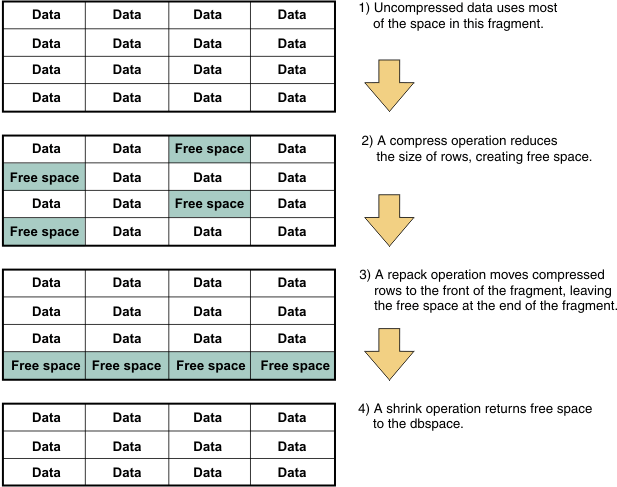Storage optimization
Data compression and consolidation processes can minimize the disk space that is used by your data and indexes.Data compression and consolidation processes can minimize the disk space that is used by your data.
The following table describes the processes that you can use to reduce the amount of disk space that is used by data in rows, simple large objects in dbspaces, and index keys. You can automate any or all of these processes or do them as needed.
The following table describes the processes that you can use to reduce the amount of disk space that is used by data. You can automate any or all of these processes or do them as needed.
| Storage optimization process | Purpose | When to use |
|---|---|---|
| Compressing | Compresses data in table
or fragment rows, reducing the amount of required disk space Compresses data in tables and fragments, compress simple
large objects in dbspaces, and compresses keys in indexes. Reduces
the amount of required disk space. After you enable compression, new data or index keys is automatically compressed. |
When you want to reduce the size of 2000 or more rows of data, simple large objects in dbspaces, or 2000 or more index keys When you want to reduce the size of 2000 or more rows of data in a table |
| Repacking | Consolidates free space in tables, fragments, and indexes.Consolidates free space in tables and fragments. | After you compress or when you want to consolidate free space |
| Shrinking | Returns free space to the dbspace. | After you compress or repack or when you want to return free space to the dbspace |
| Defragmenting | Brings data rows closer together in contiguous, merged extents.Brings data rows or index keys closer together in contiguous, merged extents. | When frequently updated tables or indexes become scattered among multiple non-contiguous extentsWhen frequently updated tables become scattered among multiple non-contiguous extents |
The following illustration shows uncompressed data that uses most of the space in a fragment, free space that is created when the data is compressed, free space that is moved to the end of the fragment after a repack operation, and data that remains in the fragment after a shrink operation. The process for storage optimization of indexes is the same.
